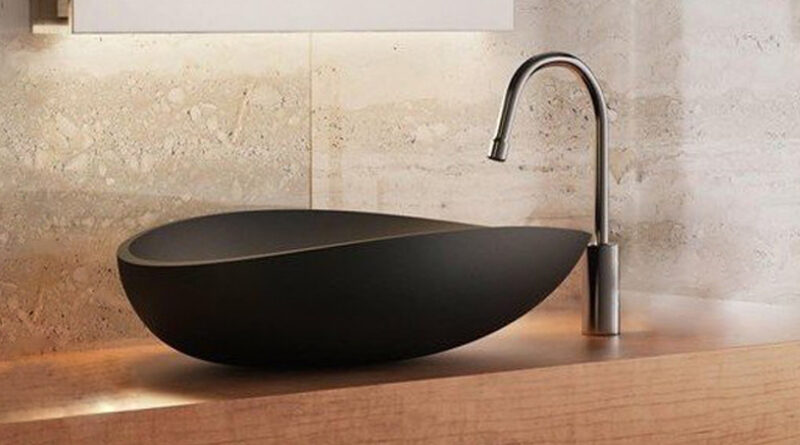What Are the Pros and Cons of Bathroom Faucets Brushed Nickel
Brushed Nickel Bathroom Faucet
Choosing the right appliances can significantly enhance the space style and functionality when redesigning or updating your bathroom. Among the various materials and finishes available, brushed nickel bathroom faucets have become a popular choice for homeowners. However, one of the primary drawbacks of brushed nickel faucets is that they may not match as seamlessly with certain bathroom styles or color schemes that could better complement more traditional or specific modern finishes, potentially limiting their versatility in some design contexts.
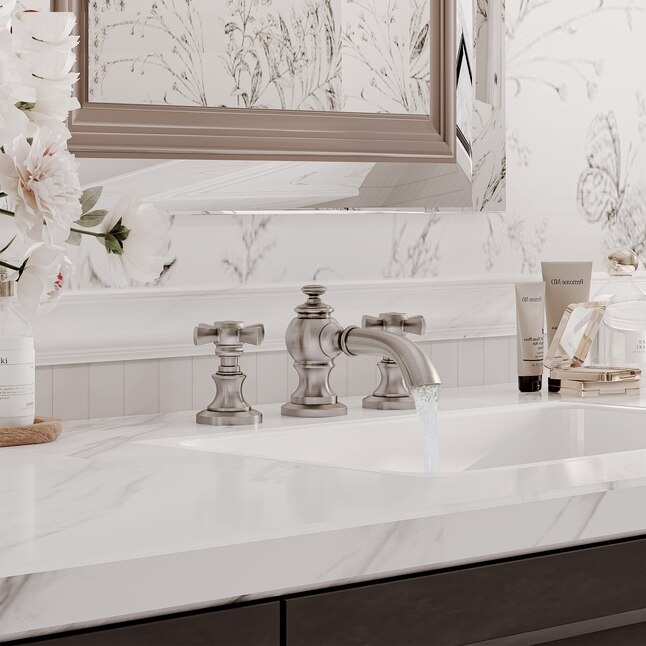
When a homeowner chooses a brushed nickel finish, be it a bathroom faucet, hardware, or other bathroom fixtures, it feels like they are striking a balance between style, durability, and practicality. Homeowners appreciate its soft, warm metallic tone that blends well with various bathroom styles, from modern to traditional, without being too reflective or overwhelming. It’s known for its resistance to fingerprints and water spots, making it easier to maintain than polished chrome. However, many have primary concerns, including ensuring consistency across different brands, as brushed nickel can have subtle variations in tone and the potential for gradual tarnishing or discoloration over time in high-humidity environments. Although it’s more durable than some finishes and less prone to scratches, however, it requires occasional cleaning to prevent mineral buildup, especially in areas with hard water. Ultimately, although the brushed nickel is a sophisticated yet low-maintenance choice, you need to ensure it complements other bathroom elements and remains consistent throughout the space.
In this blog post, we will look into the pros and cons of nickel faucets to help you determine if they fit your bathroom’s design and functionality needs. We will also explore Why they are so favored? highlighting their versatile aesthetic and low-maintenance appeal and What makes them durable? focusing on their corrosion-resistant properties and long-lasting textured finish. Also, we will go into details regarding the brushed nickel vs chrome and discover all the pros and cons related to these two most popular finshes. We will also touch basis on brushed nickel versus stainless steel and what are the pros and cons.
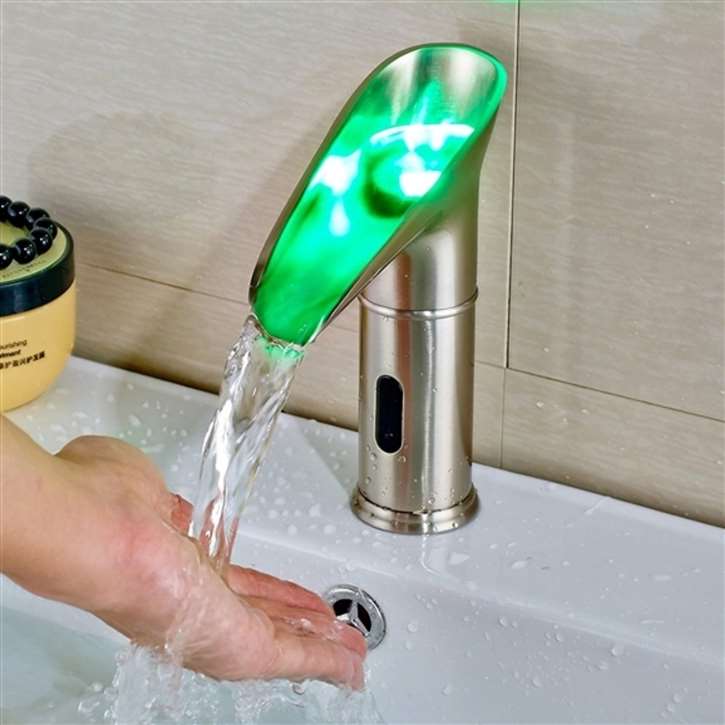
What is a Brushed Nickel Finish
They are textured nickel, also known as matte nickel, a finishing process where the metal surface is engraved with a wire brush or similar tool to create a textured appearance. This finish is applied over nickel, providing a warm and subtle tone that is less shiny than chrome.
The technique aims to give a consistent appearance that is sophisticated and resistant to the everyday wear and tear of the bathroom.
Pros of Bathroom Faucets Brushed Nickel
When choosing bathroom faucets, this finish strikes the perfect balance between style, durability, and practicality, but why are they so popular, and what makes them stand out from other finishes? Let’s explore the key benefits and why they remain a top choice for modern bathrooms. Here are some pros of these faucets to look at:


Timeless Beauty
Their understated elegance ensures they remain stylish for years without appearing outdated. Unlike chrome’s high-gloss sheen, this finish offers a softer, less reflective surface—a matte finish that provides a unique aesthetic compared to traditional chrome. This elegance can blend seamlessly with various decor styles, from modern to classic.
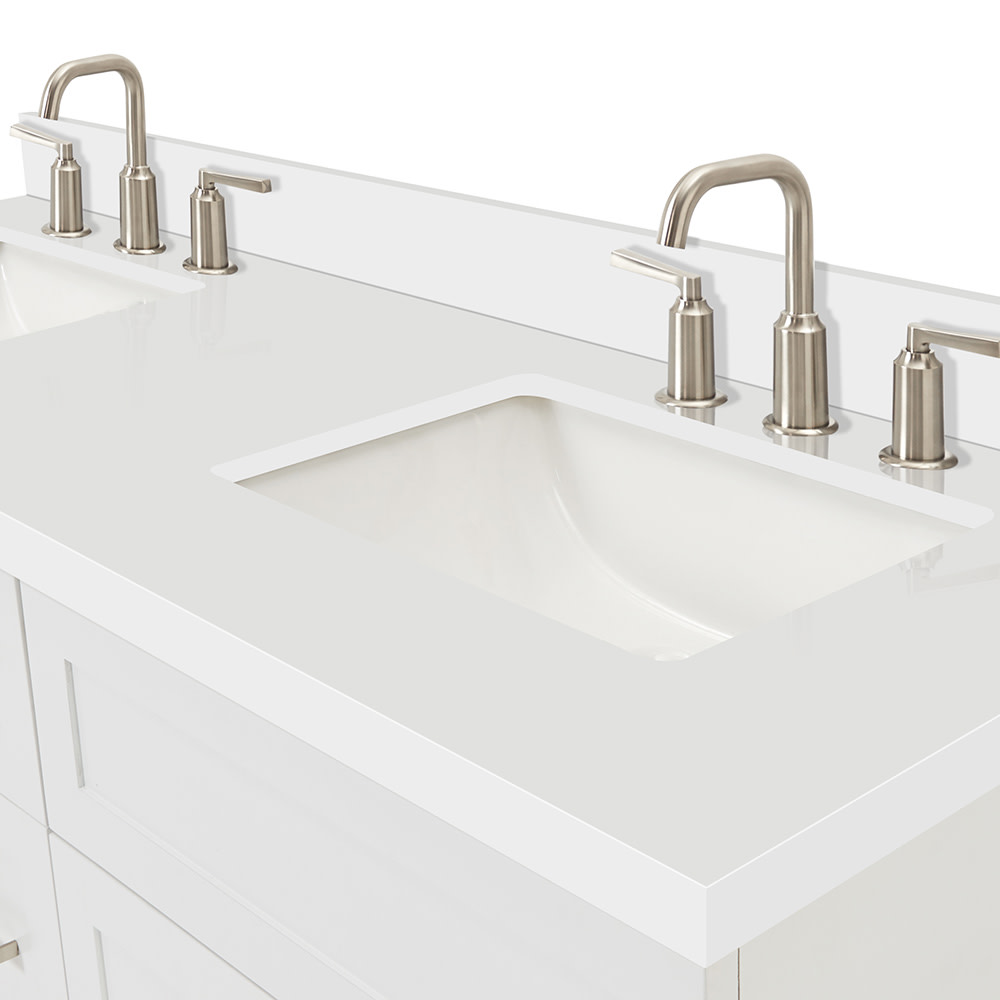
The warm and understated tone of nickel also helps create a welcoming and calming bathroom environment, which makes it a perfect choice for a space meant for relaxation.
Versatility in Design
Versatility allows easy coordination, creating a cohesive and harmonious design. The neutral nickel color complements many bathroom color schemes and materials such as marble, granite, and wood. This adaptability makes it easier for homeowners to match with existing or planned decor. Although the nickel brushed faucets may be limited in coordinating with other fixtures however we recommend reading more to find out.
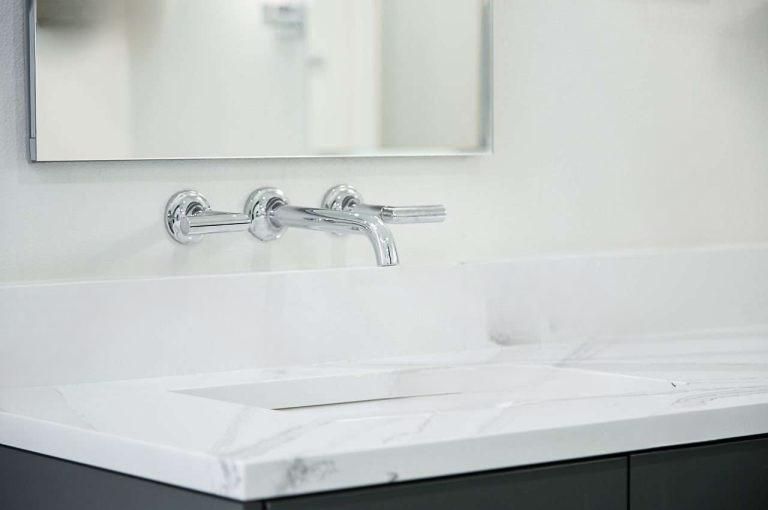
Whether you are renovating a contemporary bathroom or updating a more traditional space, these brushed faucets can fit beautifully without dominating the design with a neutral tone that blends harmoniously with a wide range of color palettes, from bold and dramatic to soft and understated.
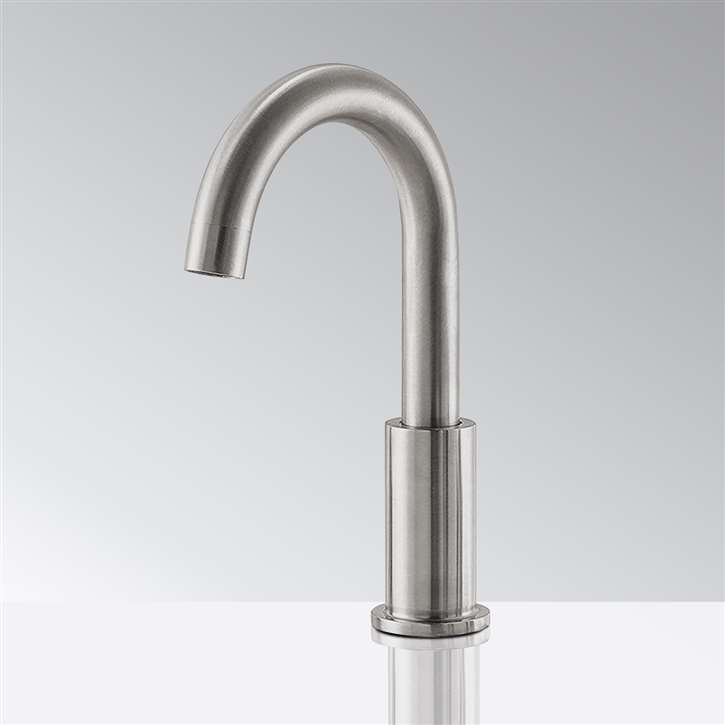
Resistance to Fingerprints and Water Spots
One of the significant advantages of matte nickel is its resistance to fingerprints and water spots. Unlike polished surfaces, its matte finish does not show smudges or dirt easily. This can help you keep your bathroom looking cleaner.
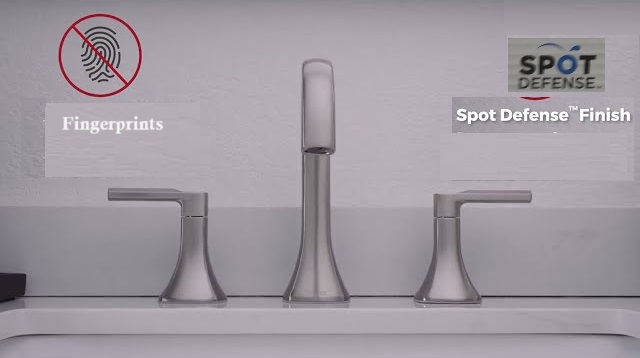
This feature is especially beneficial in busy bathrooms or homes with young children. It keeps surfaces clean without constant maintenance, which is a priority.
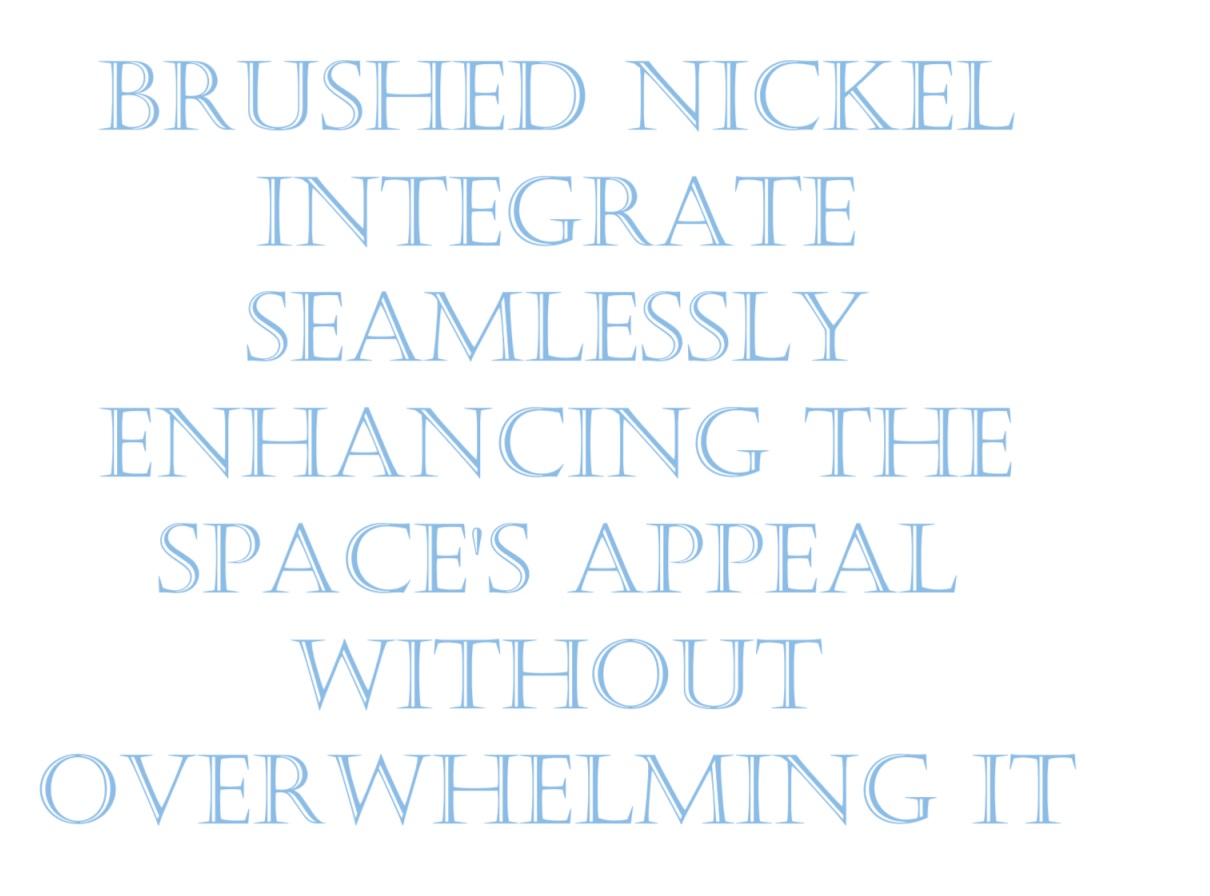
Longevity
These brushed faucets are also known for their durability. The finish does not easily tarnish, corrode, or flake off, which means they can maintain their appearance for many years with proper care.
This makes them a cost-effective investment, as they do not require frequent replacement.
In short, they are highly regarded for their exceptional durability and are a reliable choice for long-term bathroom use. Since this finish is inherently resistant to tarnishing, corrosion, and flaking, even in high-moisture environments with such robust protection, it ensures that the faucets maintain their pristine appearance and functionality for years with minimal upkeep. Unlike some other finishes that may chip or fade over time, the finish is designed to withstand daily wear and tear while retaining its sophisticated matte look. This durability makes it a cost-effective investment over time. Since they require little maintenance and are less likely to need replacement than other finishes, they save homeowners money in the long run. Their resilience also reduces the need for repairs or refinishing, making them an ideal choice for busy households or commercial settings. With proper care, such as cleaning with mild soap and a soft cloth to preserve the finish, these faucets can provide enduring performance and elegance, solidifying their value as a lasting addition to any bathroom.

Cons of Bathroom Faucets Brushed Nickel
While there are many benefits, there are also some drawbacks to consider before deciding on matte nickel faucets for your bathroom.
Initial Investment Brushed Nickel vs Chrome
Generally, these faucets can be more expensive than their chrome counterparts. The higher cost can be a consideration for those working within a strict budget.
However, it’s important to weigh the initial investment against the long-term benefits, such as durability and ease of maintenance.
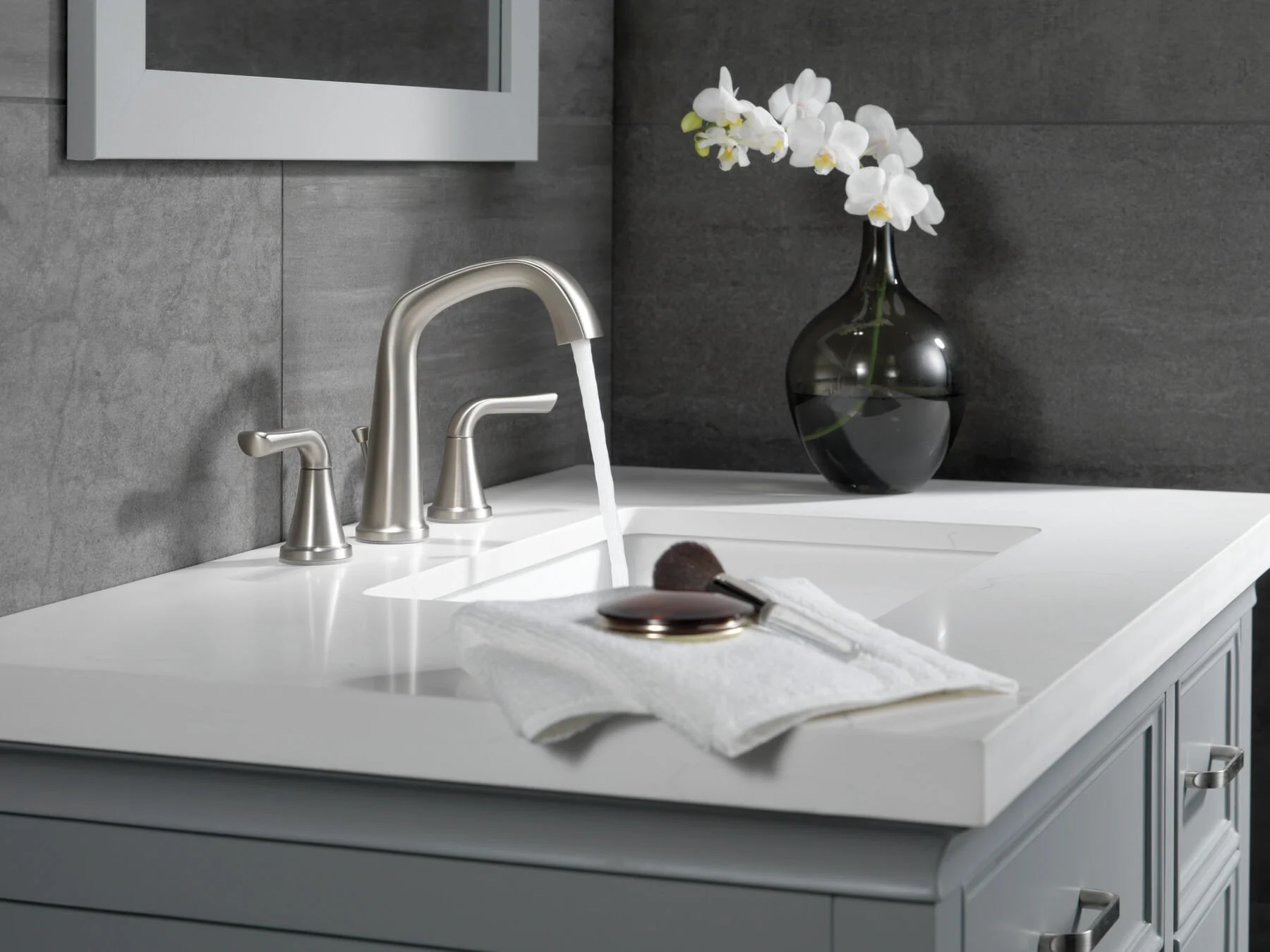
Limited Style Coordination
While matte nickel is versatile, it may not match every bathroom style perfectly. For instance, in bathrooms like ultra-modern or specific antique styles, these faucets might not blend compared to other finishes.
It’s crucial to consider the overall design vision of your bathroom before choosing textured nickel to ensure it complements other fixtures and fittings.
Special Cleaning Requirements
Although these faucets are easier to maintain on a daily basis, they might require special cleaners to avoid damage to the finish. Harsh chemicals can cause deterioration, so owners must purchase specific cleaning products.
This consideration is important for maintaining the aesthetic appeal of the faucets over their useful life.
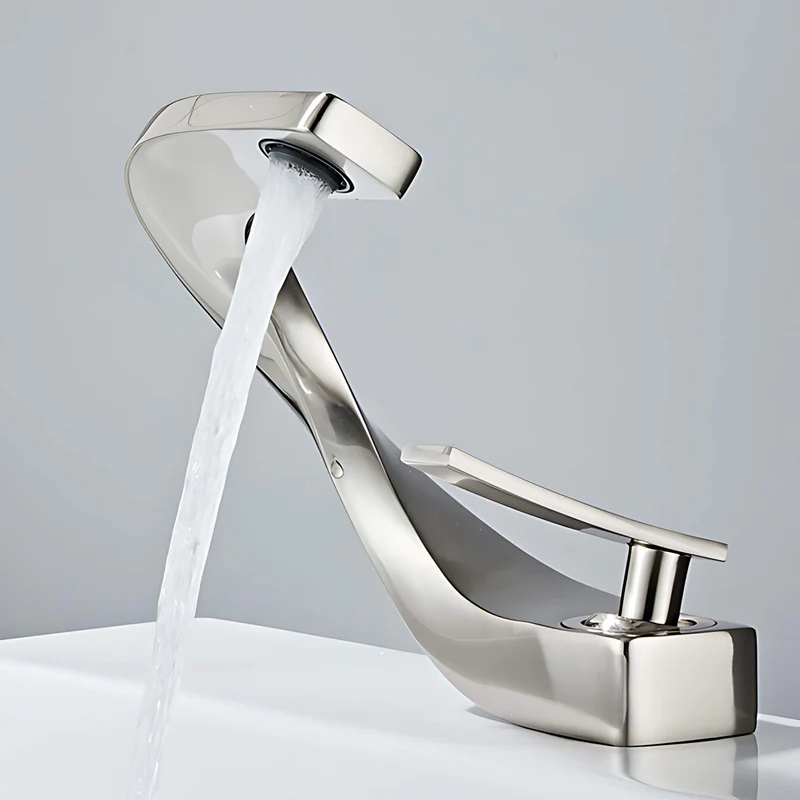
Among various finish options, gray is arguably the best color to pair with satin nickel faucets in a bathroom. It offers a modern and sophisticated vibe, works with multiple shades, and complements nickel’s sleek, metallic finish, enhancing the overall design while maintaining a neutral backdrop.
Conclusion: chrome or brushed nickel
While Muted Nickel nickel is durable and resistant to scratches, it has a slightly textured surface due to the brushing process. This texture can make it slightly more challenging to clean compared to chrome, as dust and grime may settle in the grooves of the finish. However, brushed finish is less likely to show water spots, and its matte appearance can better conceal minor imperfections and fingerprints than chrome.
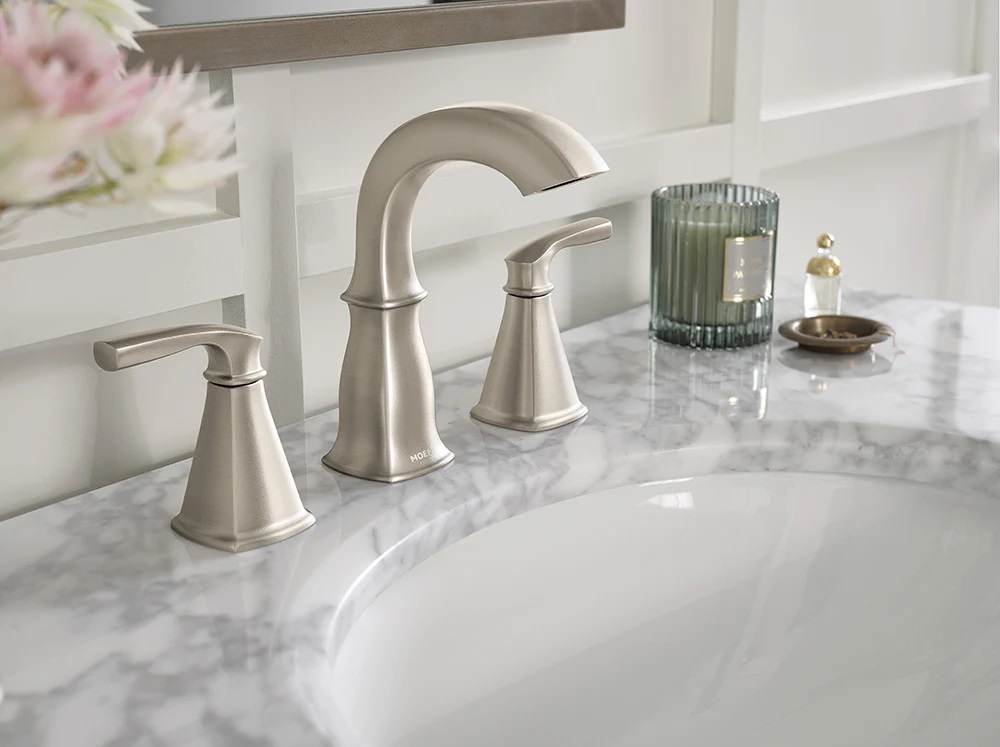
Bathroom Faucets BN Textureoffers a blend of beauty, versatility, and practicality, making them an excellent choice for many homes. However, the higher cost and specific maintenance requirements are important factors to consider.
By comparing the above pros and cons, you can make the right decision that best suits your bathroom’s design and personal preferences. As you explore your options, consider how the faucets will integrate into your overall bathroom design and how they will function as part of your daily routine.
When choosing between Textured Nickel vs Chrome finishes, each has its own set of pros and cons. Nickel offers a warm, subtle sheen that resists fingerprints and water spots, making them ideal for busy households. They are available in many functions. Single Hole provides a clean, streamlined look, while the Tub Faucets enhance traditional and contemporary bathroom designs with their durability and classic appeal. Subdued Nickel Sink Faucets and Waterfall Faucets add a touch of elegance and provide a versatile finish that complements various styles. BN Shower Faucets and Waterfall Bathtub Faucets deliver a consistent, soft look across the bathroom, while the LED Faucets offer a modern twist with practical functionality. Neutral Nickel Kitchen Faucets and Kitchen Touch Faucets are favored for their practicality and long-lasting finish.
On the other hand, Chrome Faucets are known for their mirror-like finish, which adds a bright, clean look to any space. They are available in many functions, including Single Hole Bathroom Faucets and Tub Faucets reflect light, making small bathrooms appear larger and more open. Chrome Sink Faucets and Bathroom Faucets are easy to clean and maintain, though they may show water spots and fingerprints more easily than brushed finish. Chrome Shower Faucets and Bathtub Faucets offer a sleek, modern appearance, while Waterfall Bathtub Faucets and Waterfall Sink Faucets create a striking visual effect with their cascading water flow. LED Faucets add a futuristic touch, and Chrome Kitchen Faucets and Touch Faucets bring a polished, high-gloss finish that works well in contemporary kitchens but requires more frequent cleaning to maintain their shine.
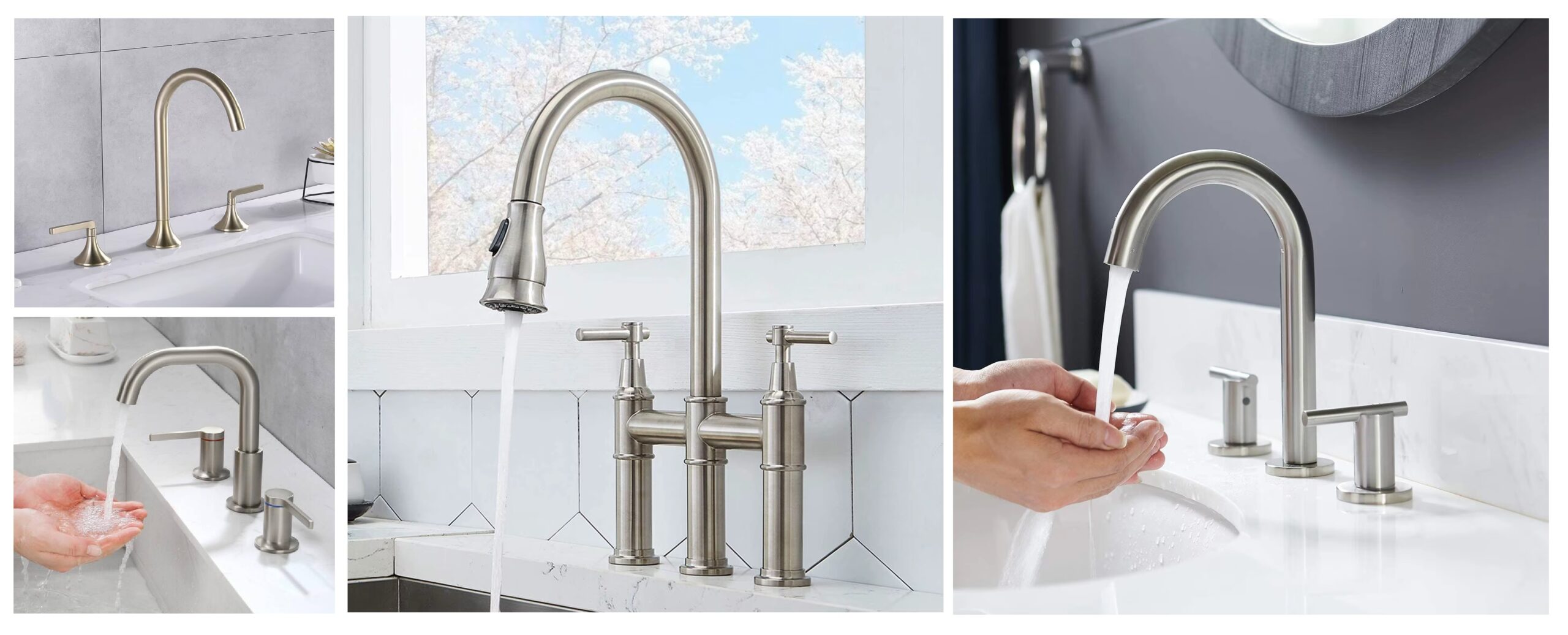
In summary, the nickel is incomparable for its strength, ease of cleaning, and style versatility among all possible finishes in bathroom fixtures. The finish is matte-like so that it doesn’t mark as much with fingerprints and water spots, making it look cleaner and longer with less cleaning for high-traffic areas like the bathroom. This finish also resists corrosion and tarnishing, making it resistant in moist conditions and economical in the long term.
Its neutral silver-gray tone will easily blend with warm and cool color schemes, allowing it to effortlessly and effectively mingle with other materials such as wood, marble, and glass.
Choosing the right fixtures can transform your bathroom into a more stylish and functional space.
For environmentally conscious homeowners and designers, this is one of the major downsides to brushed nickel. When combined with the environmental impact of its production and the maintenance issues that arise over time, it detracts from aesthetic and functional benefits. Choosing more eco-friendly finishes aligns better with sustainable design goals and reduces the carbon footprint of bathroom renovations.



























































Brushed Nickel vs Stainless steel
While nickel finish has its perks, such as fingerprint resistance and a warm, neutral tone, some of those very same pros act as downsides that may make it one hundred percent unsuitable for particular applications. From design compatibility and maintenance challenges to cost and environmental concerns, these factors should be carefully weighed before deciding to use brushed metal bathroom fixtures. Those who seek dramatic appeal, long-term durability, or eco-conscious options should consider other finishes that cater to their particular need: matte black, polished chrome, or stainless steel.
Limited Design Compatibility
Nickel is essentially recognized by its soft, mellow sheen that evokes a feeling of warmth and understatement in traditional or transitional designs. The same character often makes it less versatile for other modern or industrial bathroom styles. Contemporary bathrooms are all about bold lines, clean cuts, and striking contrasts-all aspects which nickel tends not to be complementary to. A fixture in matte black or polished chrome gives the sharpness and definition that modern design requires, whereas matte nickel is mellow or out of place.
For instance, in bathrooms with concrete or exposed brick elements highly characteristic of industrial design, nickel lacks the edge of finishes such as oil-rubbed bronze or sleek brushed nicekl refinement in polished chrome. Moreover, it fails to provide that dramatic value that is so desirable against white or dark-colored tiles, thereby failing in the statement it was meant to make. Designers going for bold or avant-garde looks might avoid the use of a nickel finish ultimately because it tends to blend in too much into the background.
You can also visit the following stores for brushed nickel bathroom fixtures by selecting HomeDepot Brushed Nickel or signature hardware
as well as Moen
https://www.fergusonshowrooms.com/decor/search.pl?Ntt=Brushed+nickel+bathroom+accessories
Brushed Nickel Color Inconsistency
One of the biggest challenges with nickel is color variation across different manufacturers. Unlike standardized finishes like chrome or matte black, which maintain consistency regardless of brand, varies a great deal in hue and texture. For instance, certain brushed fixtures may tend toward a warm, golden undertone, while others could possess much cooler, silvery hues. This inconsistency in hues makes matching fixtures when assembling a cohesive look very challenging.



For example, you may select a Textured Nickel faucet from a particular brand and take up another brand’s shower fixture in the same finish. You may find subtle but sometimes very noticeable differences in the finish of both. These variations may appear starkly definite when viewed under specific lighting conditions, especially in well-lit bathrooms. This, therefore, is one limitation that makes consumers use one manufacturer for all their fixtures, thereby limiting choices and raising their costs.
Higher Cost
The nickel fixtures are generally more expensive than chrome or matte; thus, they are not as tempting for most projects with a budget constraint. The higher cost can be attributed to the labor involved in achieving the brushed finish. This entails intricate etching or brushing to realize the fine texture that differentiates the finish from polished ones.
To the homeowner or contractor on a very tight budget, this premium may not be worth matte nickel’s benefits. Compared to other, less expensive options like chrome, which has similar durability with a sleek, modern look, the extra cost of muted nickel is dispensable. For big projects, like outfitting a whole house or even commercial space, these price differences start to add up.
Susceptible to Water Spots
Although subdued satin nickel is praised for its fingerprint-resistant properties, it’s by no means impervious to water spots and mineral deposits. In bathrooms with hard water, calcium and magnesium can deposit a visible residue on satin nickel, making it look dull and unkempt. This is particularly notorious on faucets, showerheads, and handles where water splashes more often.
For the ultimate sheen look, satin finishes require frequent cleaning and wiping down, more often than not with specialty cleaning products to prevent damage. This added care can be a real nuisance for those owners who generally favor low-maintenance finishes such as chrome, which is much easier to clean and less apt to watermark. Eventually, the need for endless care takes the glamour off of satin nickel.
Doesn’t Age Well
Unlike finishes that develop a patina or retain much of their original luster over time, satin nickel tends to degrade with age if not properly maintained. Prolonged exposure to moisture, harsh cleaning agents, or physical wear will eventually cause discoloration, fading, or dullness. For example, those installed in bathrooms of high humidity often lose that sheen and need periodic refinishing to maintain acceptability in appearance.
This is understandably infuriating for homeowners who strive to give their bathrooms a consistent look. Unlike oil-rubbed bronze, which develops a rich patina that adds character, or polished chrome, which retains its bright sheen with minimum maintenance, satin nickel ages less gracefully and often less visually appealing.
Features: Pull-out sprayer, digital temperature display, nickel finish,
solid brass construction, single-handle operation.
Price: ~$396.90
Rating: ⭐⭐⭐⭐⭐ (4.8/5)
Architect’s Review:
Kia M. (San Francisco , CA) – ⭐⭐⭐⭐⭐ (5/5)
“The Fontana Langres Kitchen Faucet seamlessly integrates advanced technology with sleek design. The digital temperature display enhances user experience, while the brushed nickel finish and solid brass construction ensure durability and a modern aesthetic. Its pull-out sprayer adds functionality, making it an excellent choice for contemporary kitchen projects. Unlike oil-rubbed bronze or matte black finishes, brushed nickel does not provide a high-contrast statement look.”
Cleaning Issues
While satin nickel is durable to some degree, it is quite sensitive to some cleaning agents. The satin texture may be scratched by abrasive cleaners, harsh chemicals, or acidic solutions that could leave tarnished spots. This sensitivity calls for mild and non-abrasive cleaners and soft cloths in cleaning the fixtures.
This kind of painstaking cleaning is in huge contrast to more durable finishes, such as chrome or stainless steel, which are more resistant to a number of cleaning substances. The extra care that satin nickel fixtures require could be considered to be impractical with especially busy homes and businesses, thus making it a little less appealing for people who want an easy-to-maintain option.
Rating: ⭐⭐⭐⭐⭐ (4.8/5)
Lack of Dramatic Effect
While the subtlety of satin nickel is ideal for understated elegance, at times, it may be to its disadvantage, particularly when bold, eye-catching fixtures are required in a bathroom design. The finish mostly marries into neutral color palettes and usually does not provide a striking contrast, unlike matte black or polished gold.
For example, in a minimalist bathroom design, a faucet in satin nickel might look subtle against white or gray–tiled backgrounds. In contrast, a matte black or chrome fixture might be used as a focal point to deepen the space and create visual interest. Because satin nickel does not have this same dramatic presence, it‘s not suitable for those designs that wish to make a big statement.
Environmental Concerns of Satin Nickel in Bathroom Fixtures
Satin nickel is the most in-demand finish in bathroom fixtures because of its understated sheen and warm undertones that also provide fingerprint resistance. But behind that look lies a manufacturing process that is decidedly not green. The manufacturing of satin nickel is very resource-intensive, with heavy electroplating and brushing that use up an awful lot of energy, using hazardous chemicals in the process. These processes, along with issues regarding disposal and sustainability, make satin nickel less friendly towards the environment than alternatives such as powder-coated matte black or recycled stainless steel. This section discusses environmental issues arising in the manufacture of satin nickel and considers greener alternatives that are more in tune with values involving ecological concerns today.
The Highly Resource-Consuming Manufacturing Process of Satin Nickel
1. The Electroplating Process
The main step for the satin nickel finish is electroplating. Electroplating involves using an electric current to deposit a thin layer of the material, in this case, nickel, onto a base material, which is usually made of brass or zinc. While this provides satin nickel with its signature hardness and resistance to corrosion, the process is very energy-intensive and creates a lot of waste. The steps generally include:
Preparation: The substrate is cleaned and polished to remove impurities. This process consumes water and chemicals, increasing resource use. The material is dipped in baths with electrolyte solutions containing nickel salts, which allow the deposition of nickel. These baths often contain hazardous chemicals such as nickel sulfate, nickel chloride, and boric acid that pose risks to human health and the environment.
Energy Consumption: Electroplating is a continuous electric current process that is very power–consuming, especially in industrial sectors with large-scale production. Waste from electroplating includes chemical-laden water, heavy metals, and toxic sludge, all requiring proper waste treatment. Poor waste management could result in the contamination of soil and water, which would further cause long-term ecological damage.



2. Brushing
After electroplating, the nickel surface is brushed to give its characteristically satin texture. But while this increases the aesthetic value, it also escalates the environmental cost further because:
Abrasive Materials: Fine metal dust and brushing waste should be collected and disposed of responsibly. Poor management could result in air and water pollution.
Energy Consumption: Brushing involves mechanical processes and, therefore, requires special machinery, which again increases energy consumption.



Harmful Chemicals and Environmental Effects
The chemicals involved in electroplating and brushing satin nickel pose significant risks to workers and the environment. Key concerns include:
Toxic Wastewater: Electroplating generates wastewater with high levels of heavy metals like nickel and chromium. This wastewater can pollute aquatic ecosystems and bioaccumulate through the food chain if untreated.
Air Pollution: Manufacturing satin nickel fixtures can release VOCs and metallic fumes, which can harm workers and nearby communities and cause respiratory issues and other health problems.
Solid Waste: Electroplating sludge contains concentrated nickel and other hazardous substances. While recyclable, improper disposal can lead to landfill contamination.
Energy Consumption and Carbon Footprint
Satin nickel manufacturing is an energy-intensive process; thus, it generates a higher carbon footprint than any other finish. Since electroplating and brushing processes are dependent on non-renewable energy sources, this increases greenhouse gas emissions. Mining and processing the raw materials used in satin nickel, like nickel and brass, contribute much to environmental degradation through deforestation, habitat destruction, and soil erosion.



Difficulty in Recycling Satin Nickel
The surface is electroplated, making satin nickel fixtures challenging to recycle. The nickel must be removed to recycle the base material, adding energy and cost to the process. Most satin nickel fixtures end up in landfills, where they do long-term environmental damage.
Comparison with Greener Alternatives
1. Powder-Coated Matte Black
The powder-coating processes are more environmentally friendly replacements for satin nickel. The dry powder is applied on a surface and cured under heat to have the following advantages, among others:
Zero VOCs: Powder coating does not emit harmful volatile organic compounds compared to electroplating.
Energy Efficiency: The process of curing uses less energy compared to electroplating, hence reducing carbon emissions.
Recyclability: Powder-coated materials are easier to recycle because the stripping of the coating will not affect the base material.
2. Recycled Stainless Steel
Stainless steel stands a step ahead of satin nickel in terms of environmental impact. Most stainless steel is made from recycled metals. It is 100% recyclable and fits well within circular economy principles. Moreover, it provides a fashionable look that’s modern and further resistant to water spots and corrosion.
Sustainable Practices in Fixture Manufacturing
Manufacturers can reduce the ecological footprint of satin nickel through sustainable practices such as:
Wastewater Treatment: Reuse of wastewater from electroplating through advanced filtration systems.
Renewable Energy: Transition of production facilities to renewable energy sources.
Environmentally Friendly Materials: Screening for less resource- and chemical-intensive finishes.
Concluding Notes
While having its aesthetic and functional benefits, Satin nickel is less eco–friendly in the development of bathroom fixtures because of its resource-heavy process and involvement of hazardous chemicals. Powder-coated matte black and recycled stainless steel emerge as greener alternatives that meet modern design needs and sustainability goals. Informed choices by environmentally conscious consumers will support brands that respect sustainability and, therefore, bridge the gap between style and functionality with ecological responsibility.








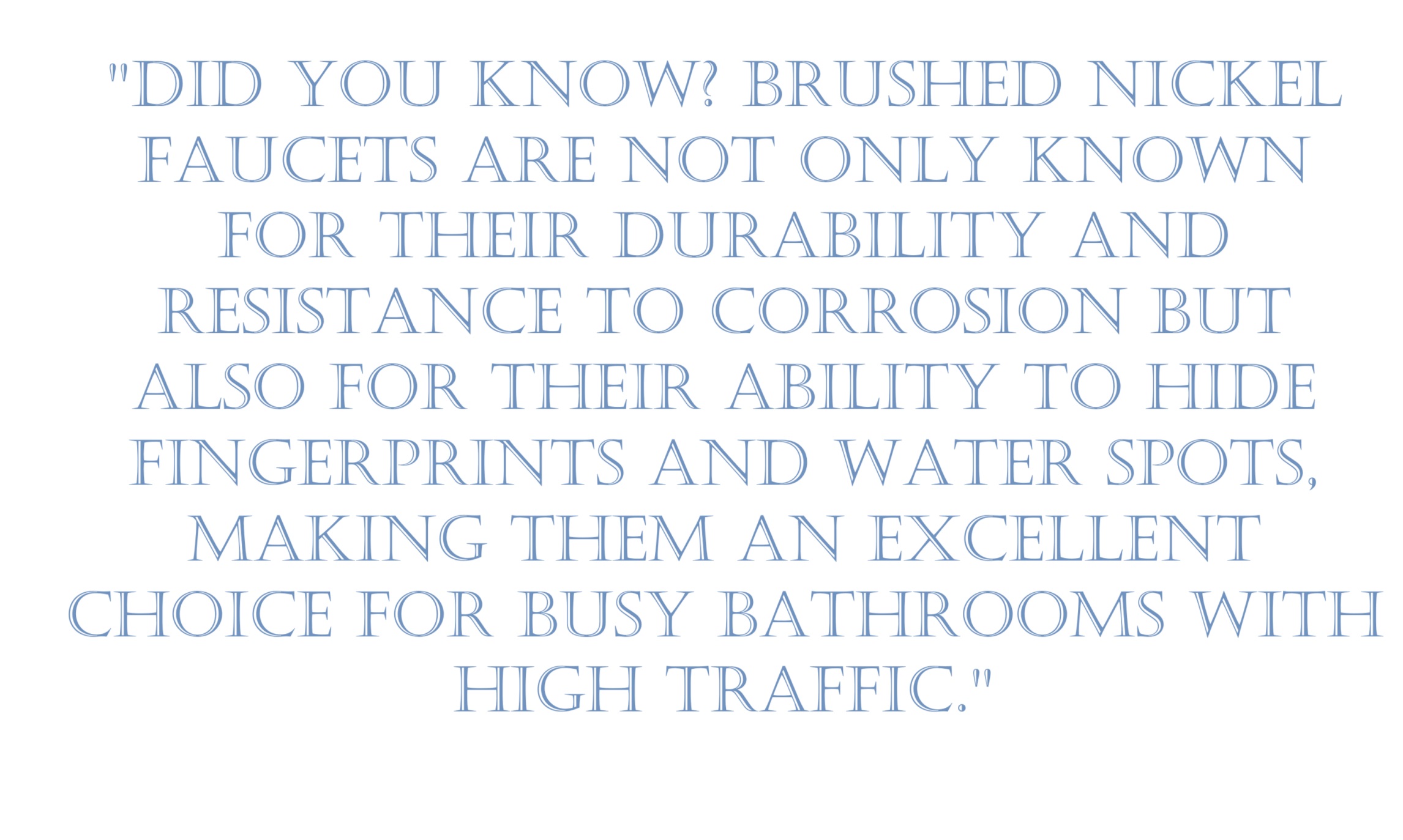
Check other Blogs:
Tips to maintain the champagne bronze faucets
The following FontanaShowers blog offers some real-life great tips to keep champagne bronze faucets elegant-looking and excellent functioning. The guide underlines the importance of using gentle, pH-neutral cleaning solutions that will not destroy the finish but avoid using bleach or ammonia on them. Regular wipe-downs and weekly deep cleanings help prevent water spots and buildup, allowing the finish to remain warm and shiny. These simple care steps will keep champagne bronze fixtures looking beautiful and lasting long.
How to replace a bathroom faucet
This includes what kind of tools one will need, preliminary steps such as shutting off the water supply, and how to carefully remove the old faucet and install a new one. In this post, learn from removing the old faucet and drain assembly to securing the new fixture in place and then checking for leaks. This pragmatic mode of replacement will help make the installation hassle-free and give your bathroom a whole new look.

FontanaShowers
FontanaShowers blogs contain a vast amount of information, including technical data, installation tips, and maintenance advice for luxury bathroom fixtures. These blogs have an important role to play in helping clients make informed choices, highlighting certain unique features of their products, and recommending professional advice that enhances the entire user experience... Read More
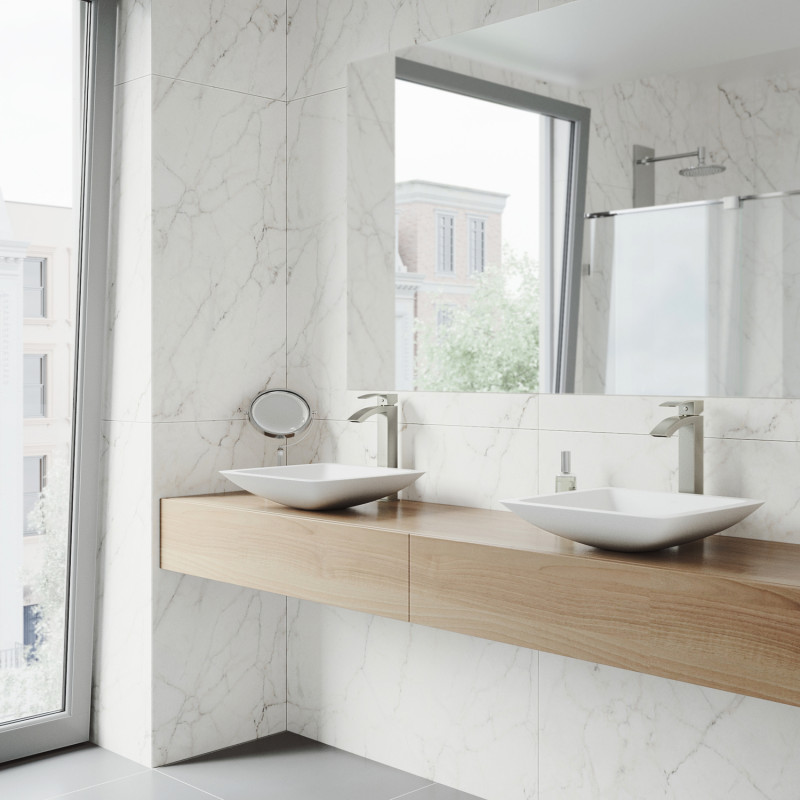

Brushed nickel bathroom faucets are a popular traditional or rustic setting choice for both residential and commercial settings..One of the primary advantages of brushed nickel faucets is their resistance to fingerprints and water spots
Read Pros and Cons of Brushed Nickel Bathroom Faucets More
Keep your champagne bronze faucet looking new with these essential maintenance tips.
Discover 6 Tips for Maintaining Your Champagne Bronze Bathroom Faucet Tips
A step-by-step guide to replacing your bathroom faucet with ease.
Learn How to Replace a Bathroom Faucet
Discover the advantages of installing touchless faucets in your bathroom.
Explore Benefits of Touchless Bathroom Faucets
Find out why Lowe’s bathroom faucets are a sustainable choice.
Read Sustainability in Lowe’s Bathroom Faucets
Explore the top brands offering the best shower heads for your bathroom.
View Top Brands for Shower Heads
Check out our recommendations for the best touchless soap dispensers available.
Discover Best Touchless Soap Dispensers
Discover the features that make these luxury shower systems worth the investment.
Explore The Most Expensive Luxury Shower Systems
Get insights on the top-rated toilets for 2024 based on consumer reviews.
Read the Consumer Reports: Toilets of 2024 Report
Keep your antique brass faucet in top shape with these 7 tips.
Learn Maintaining Your Antique Brass Bathroom Faucet Tips
Find out what sets the gold shower set apart from other finishes.
Read Unique Features of the Gold Shower Set
Weigh the benefits and drawbacks of installing a shower panel in your bathroom.
Learn Shower Panels: Pros and Cons
Explore the timeless appeal of the oil rubbed bronze shower system.
Oil Rubbed Bronze Shower System View Details
Check out the top distributors providing quality plumbing fixtures.
Leading Plumbing Distributors Explore Here
Find the best brands for touchless faucets in commercial and residential spaces.
Top Brands for Touchless Bathroom Faucets Discover Brands
Discover how experiential design trends are shaping modern hotel bathrooms.
Future of Hotel Bathroom Design Read More
Learn about the advantages of using commercial faucets in your restaurant.
Are Commercial Restaurant Faucets Right for Your Business?
Read our take on shower mixer brands to avoid.
Worst Shower Mixer Brand Review Read the Review
Explore the best smart toilet brands for advanced features and comfort.
Top Brands for Smart Toilets View Brands
Find out what makes FontanaShowers a top choice among bathroom fixture brands.
FontanaShowers Among Top 20 Bathroom Fixture Brands Learn More
Discover faucet styles that are ideal for compact bathrooms.
Best Bathroom Faucets for Small Bathrooms View Options
Find the top shower heads available at Home Depot.
Best Shower Head at Home Depot Explore Options
See our pick for the best bathtub brands for quality and design.
Best Bathtub Brand in 2024 Learn More
Read the study on implementing Fontana touchless faucets in airport restrooms.
Study on Replacing Manual Faucets with Touchless Solutions in Airports
Explore top-rated soap dispensers for high-traffic restrooms.
Best Automatic Soap Dispenser Brands for Public Restrooms Discover Brands
Find out which brands lead the smart toilet market in 2024.
Smart Toilet Brands of 2024 Explore Here
Discover the benefits of choosing bathroom sink and faucet combos.
Why Combine Bathroom Sinks with Faucets?
Find out how oil rubbed bronze faucets can complement modern aesthetics.
Oil Rubbed Bronze Faucets in Modern Designs
Explore potential downsides to installing touchless faucets in bathrooms.
Drawbacks of Touchless Bathroom Faucets
Discover the benefits of touchless faucets in airport settings.
Impact of Fontana Touchless Faucets in Airport Restrooms
Get expert tips on designing functional and hygienic airport restrooms.
How to Design Airport Restrooms
Explore innovative smart toilet options for modern bathrooms.
Smart Toilets
Get insights on automatic soap dispensers from top architects and designers.
Architects’ Reviews of Automatic Soap Dispensers
Discover the best faucet brands for 2025.
Top Faucet Brands of 2025
Explore FontanaShowers’ collection of commercial bathroom faucets.
Commercial Bathroom Faucets from FontanaShowers
Get insights from consumer reviews on the top touchless faucets for 2024.
2024 Consumer Report: Best Touchless FaucetsRead Report

